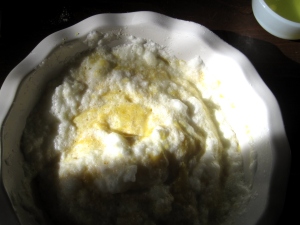When I was a kid, the jobs that required unusual patience were given to me, for better or worse. My sister Amanda will remember that I took over the Easter bread dough every year at the very end of the process, when it needed cup after cup of flour kneaded into it until the dough was smooth and elastic. It’s tempting to add it in a heap and get on with your life, but then you end up with a mucky, sticky, dusty mess. It has to be done slowly.
Then there was melon-balling for our Fourth of July barbecue. I’d work the flesh out of half of a watermelon the size of an ottoman and add it to honeydew and blueberries to make fruit salad. Then the whole shebang would go back into the watermelon half. This took a while, and there was no way to cut a corner.
Along with not rushing the processes we can control, I wait for seasonal produce. I know I’m an exception. But I maintain that waiting all winter means a kaboom of true green flavor when you bite into that first stalk of roasted asparagus, greenness that gets right in the face of all of the cold and mud and ice and grit you’ve endured for months. It tells you, without question, it’s OVER.
Waiting means strawberries that are so ripe that they stain my fingers red when I pick them, and taste like sunbeams. It means the immense joy of a warm, slightly soft, utterly ripe heirloom tomato; a freshly picked apple that cracks audibly when you bite into it; and the mellow richness of a Lumina pumpkin, chosen from a wagon 32 steps away from the vine where it snoozed in the sun all summer. (Mario Batali got almost misty when he described the flavor of fresh fall produce: “You can taste that the ground has changed.” I can’t do better.) Our ancestors had no choice but to wait for what grew, and reaped the benefits of waiting. They knew from flavor.
There’s an art to holding out for something until it’s ready. Bite into a peach that’s gorgeous and hard as a rock and you’ll get a mouth full of nothing. A blackberry that’s glossy and firm guarantees you an almost painful tartness. A ripe berry will fall off into your palm with the gentlest tug. Forcing it means it’s not ready and not worth the lack of flavor.
Sometimes fruits and vegetables look (to our persnickety, Madison-Avenued eyes) their worst when they’re the most delicious and ripest. Passion fruits are ready when they’re half shriveled. One of my readers, a retired Southern farm wife, swears by the exceptional flavor of summer squash that’s covered in blemishes and warts. And fresh figs—they’re hardly worth eating if they’re not cracked and oozing.
You won’t find produce in stores looking like this, because consumers have grown detached from what food looks like when it’s ripe, and won’t buy it. Seek it out at farms, farmers’ markets, and orchards if you can’t score some off your neighbors who have a fig tree.
There’s an art to waiting for edibles and for non-edibles, for the things we can control (a little or a lot) and the things we can’t. And while I have been credited with having great patience…full disclosure, it ain’t always easy. Sometimes the art fails me. Sometimes it’s bloody hard.
This helps: I think back to a couple of weeks ago when I took a walk along the lake and found two or three patches of wild mint. It’s growing in profusion, because mint can hardly grow any other way. No one planted it. The universe deemed the time and place right, so up it came, and healthy as the day is long, too. If I tasted it in March, it wouldn’t have the bite and sweetness it grew into under the sun and rain all of these months. Mint, like all growing things, is ready when it’s ready. It’s a reminder that I can work for the things I can control, but everything else will come in time, the way it’s supposed to. That’s a comfort. And I couldn’t stop it if I tried.





